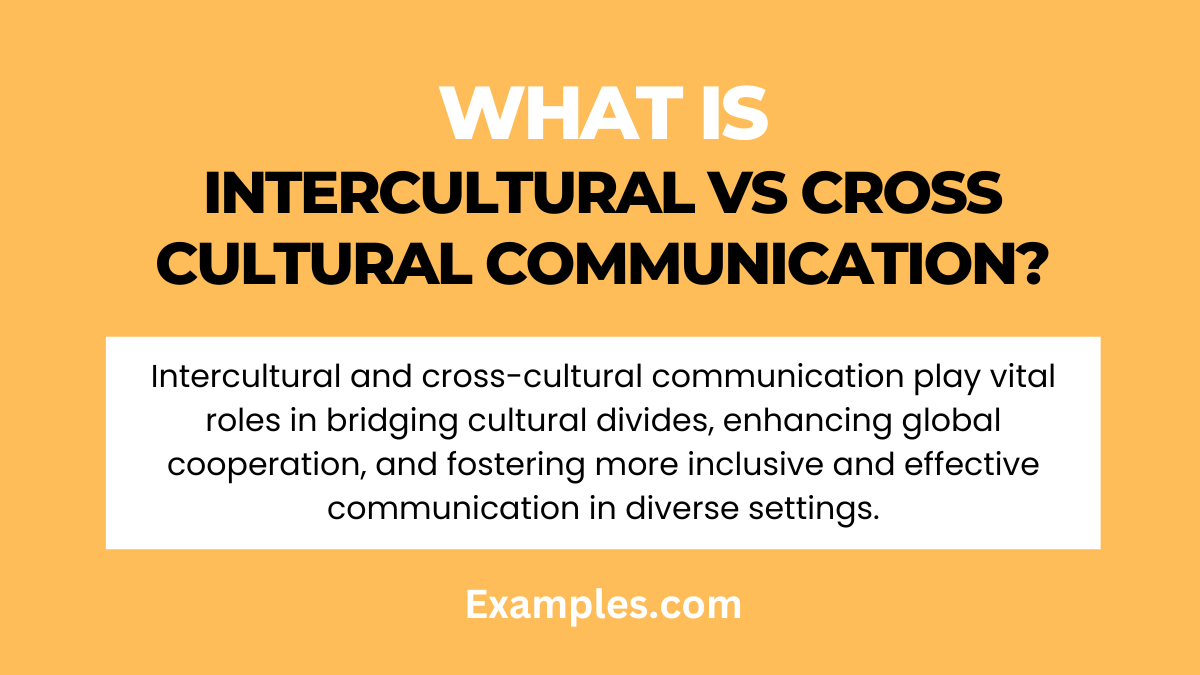Intercultural vs Cross Cultural Communication – 9+ Examples
Navigate the complex world of communication across cultures with our in-depth guide on Intercultural vs Cross Cultural Communication. This resource distinguishes between the nuances of intercultural and cross-cultural dynamics, enriched with practical Intercultural Communication Examples. Discover how these forms of communication differ, their unique challenges, and their significance in our increasingly interconnected world. Ideal for professionals and students alike, this guide provides insights and strategies for effective communication in diverse cultural contexts.
What is Intercultural vs Cross Cultural Communication?

Intercultural communication refers to the interaction between individuals from different cultural backgrounds. It focuses on understanding and managing the diverse communication styles, beliefs, and practices that arise when people from various cultures interact. This type of communication is crucial in a globalized world, as it promotes mutual understanding and effective collaboration across cultural boundaries.
Cross-cultural communication, on the other hand, typically involves comparing and contrasting the communication styles, norms, and practices of different cultures. It often aims to identify general patterns or differences in communication across cultures, rather than focusing on interactions between individuals. Cross-cultural communication is essential in understanding broader cultural dynamics and can be used to develop strategies for better intercultural interactions.
Both intercultural and cross-cultural communication play vital roles in bridging cultural divides, enhancing global cooperation, and fostering more inclusive and effective communication in diverse settings.
Difference Between Intercultural and Cross Cultural Communication
In the realm of Intercultural Communication, it’s vital to distinguish between intercultural and cross-cultural communication. Both play a significant role in our increasingly interconnected world. Below is a comprehensive guide laid out in a table format, contrasting these two types of communication to provide a clear understanding.

| Intercultural Communication | Cross Cultural Communication |
|---|---|
| Focuses on interactions between individuals from diverse cultural backgrounds. | Analyzes communication styles and patterns across different cultures. |
| Aims for mutual understanding and effective communication between different cultures. | Seeks to identify, compare, and understand cultural communication differences. |
| Involves real-time adaptation of communication styles during interactions. | More analytical, studying how culture influences communication. |
| Emphasizes personal, direct interactions within a variety of cultural settings. | Often involves broader, more theoretical analysis of cultural communication. |
| Centrally concerned with building relationships and empathetic understanding. | Aims to provide insights into how different cultures communicate. |
| Develops skills for navigating cultural nuances and fostering intercultural empathy. | Focuses on the broader comprehension of global communication trends. |
| Examples include multicultural teamwork and international negotiations. | Examples include comparative studies of business practices across cultures. |
| Key in everyday global interactions, international business, and diplomacy. | Essential for researchers, educators, and global strategists. |
| Challenges include overcoming cultural barriers and misinterpretations. | Challenges in avoiding overgeneralization or cultural stereotyping. |
| Directly applicable in diverse fields like education, healthcare, and business. | Applied in creating effective cross-cultural training programs and policies. |
| Enhances global competence and intercultural relationship building. | Provides a macro view of communication across different cultural landscapes. |
| Tailored to specific, individual cultural interactions and exchanges. | Involves a more general overview of inter-group communication dynamics. |
| Essential for professionals working in international or multicultural environments. | Important for academic research and developing global communication strategies. |
10 Examples of Intercultural Communication
Intercultural communication involves direct interaction between individuals from different cultural backgrounds, focusing on sharing and understanding diverse perspectives. Here are 10 examples illustrating various aspects of intercultural communication:
- International Business Meetings: Professionals from different countries discussing business strategies, requiring an understanding of each other’s cultural business practices.
- Multicultural Teams in Corporations: Teams comprising members from various cultural backgrounds collaborating on projects, emphasizing the importance of Intercultural Communication in the Workplace.
- Patient-Doctor Interactions in Hospitals: Doctors communicating with patients from different cultures, necessitating sensitivity to cultural beliefs in healthcare.
- Language Exchange Programs: Individuals learning a new language by interacting with native speakers, enhancing their cultural and linguistic skills.
- Global Virtual Teams: Remote teams working across borders via digital platforms, relying on clear and culturally sensitive communication.
- Diplomatic Negotiations: Diplomats from different nations discussing international policies, where understanding cultural nuances is critical.
- Tourist-Local Interactions: Tourists communicating with locals during travels, often navigating language barriers and cultural differences.
- Intercultural Marriage: Partners from different cultural backgrounds navigating their relationship, blending various cultural practices and values.
- Educational Exchange Programs: Students studying abroad and adapting to new educational systems and cultural environments.
- International Customer Service: Customer service representatives dealing with clients from different countries, requiring adaptability and cultural awareness.
10 Examples of Cross Cultural Communication
Cross-cultural communication focuses on comparing and analyzing communication patterns and styles across different cultures. Here are 10 examples that demonstrate cross-cultural communication:
- Comparative Cultural Studies: Academic research comparing communication styles across different cultures, contributing to Intercultural Communication Theories.
- Global Marketing Campaigns: Developing advertising strategies that are culturally relevant and appealing to diverse international markets.
- Cultural Sensitivity Training for Employees: Training programs designed to educate employees about various cultural norms and practices, especially in multinational companies.
- International Film Productions: Collaborative film projects involving crews and casts from different cultural backgrounds.
- Cross-Cultural Psychology Research: Studies exploring how psychological processes differ across cultures.
- International Trade Policies Discussion: Governments discussing trade policies, where understanding cross-cultural economic practices is vital.
- Cultural Anthropology Fieldwork: Anthropologists studying and comparing cultural practices in different societies.
- International NGOs Working in Diverse Cultures: NGOs operating in various countries, adapting their approaches to suit local cultural contexts.
- Cross-Cultural Management Strategies: Managers overseeing teams in multinational corporations, employing strategies that are effective across different cultures.
- Multilingual Content Creation for Global Audiences: Creating content like websites or manuals in multiple languages, taking into account cultural nuances in communication.
Comparison Between Intercultural and Cross Cultural Communication
Unveiling the similarities between Intercultural Communication and Cross Cultural Communication, this guide emphasizes their shared goals in enhancing global understanding. Both approaches value cultural awareness, effective dialogue, and the need for empathy in diverse interactions, playing a pivotal role in international relations and global business strategies. They also focus on overcoming communication barriers, fostering cultural sensitivity, and promoting effective global collaboration.
- Business Negotiations: In both intercultural and cross-cultural settings, understanding cultural nuances is key during international business negotiations. Tailoring communication styles to respect cultural differences ensures successful outcomes.
- Global Team Collaboration: When global teams collaborate, they must consider both intercultural dynamics between team members and cross-cultural aspects of the project they are working on, emphasizing cultural sensitivity and adaptability.
- Educational Exchange Programs: Exchange programs offer students the opportunity to experience both intercultural and cross-cultural learning, enhancing their global perspective and communication skills.
- International Marketing Campaigns: Crafting marketing campaigns for a global audience requires an understanding of both intercultural and cross-cultural elements to effectively reach and resonate with diverse markets.
- Healthcare in Multicultural Settings: Healthcare professionals often navigate both intercultural interactions with patients from diverse backgrounds and cross-cultural healthcare practices, emphasizing the importance of cultural competence.
- Diplomatic Relations: Diplomats engage in both intercultural and cross-cultural communication, understanding the nuances of the cultures they interact with and comparing different cultural approaches to diplomacy.
- Cultural Sensitivity Training: These trainings encompass both intercultural and cross-cultural elements, preparing individuals to effectively communicate and work in diverse cultural environments.
- International Customer Service: Providing customer service to a global clientele involves understanding both the specific cultural needs (intercultural) and general cultural tendencies (cross-cultural) of customers.
Relationship Between Intercultural and Cross Cultural Communication
Exploring the relationship between Intercultural Communication and Cross Cultural Communication reveals a synergistic connection. Intercultural communication provides the groundwork for effective cross-cultural analysis, enriching the understanding of global communication patterns. Both forms are integral in fostering international cooperation, cultural empathy, and global business acumen, emphasizing the importance of cultural adaptability and competence in our interconnected world.
- Tourism Industry: The tourism industry thrives on intercultural interactions with tourists while using cross-cultural insights to tailor experiences to diverse cultural groups.
- Language Translation Services: Translators must understand specific cultural contexts (intercultural) and broader linguistic nuances across cultures (cross-cultural) for effective translation.
- International NGOs: NGOs operate based on intercultural interactions in local communities and use cross-cultural strategies to implement global initiatives.
- Cultural Anthropology Research: Anthropologists engage in intercultural fieldwork to gather data, which they then analyze in a cross-cultural context to draw broader conclusions.
- Global Leadership Development: Leaders are trained in intercultural competencies for direct team management and cross-cultural strategies for wider organizational impact.
- Film and Media Production: Producers create content considering intercultural elements (audience interaction) and cross-cultural themes (global appeal).
- International Art Exhibitions: Exhibitions showcase intercultural artists’ work and create cross-cultural dialogue among global audiences.
- Global Environmental Campaigns: Environmental campaigns consider intercultural local impact and cross-cultural global strategies for effective messaging and action.



